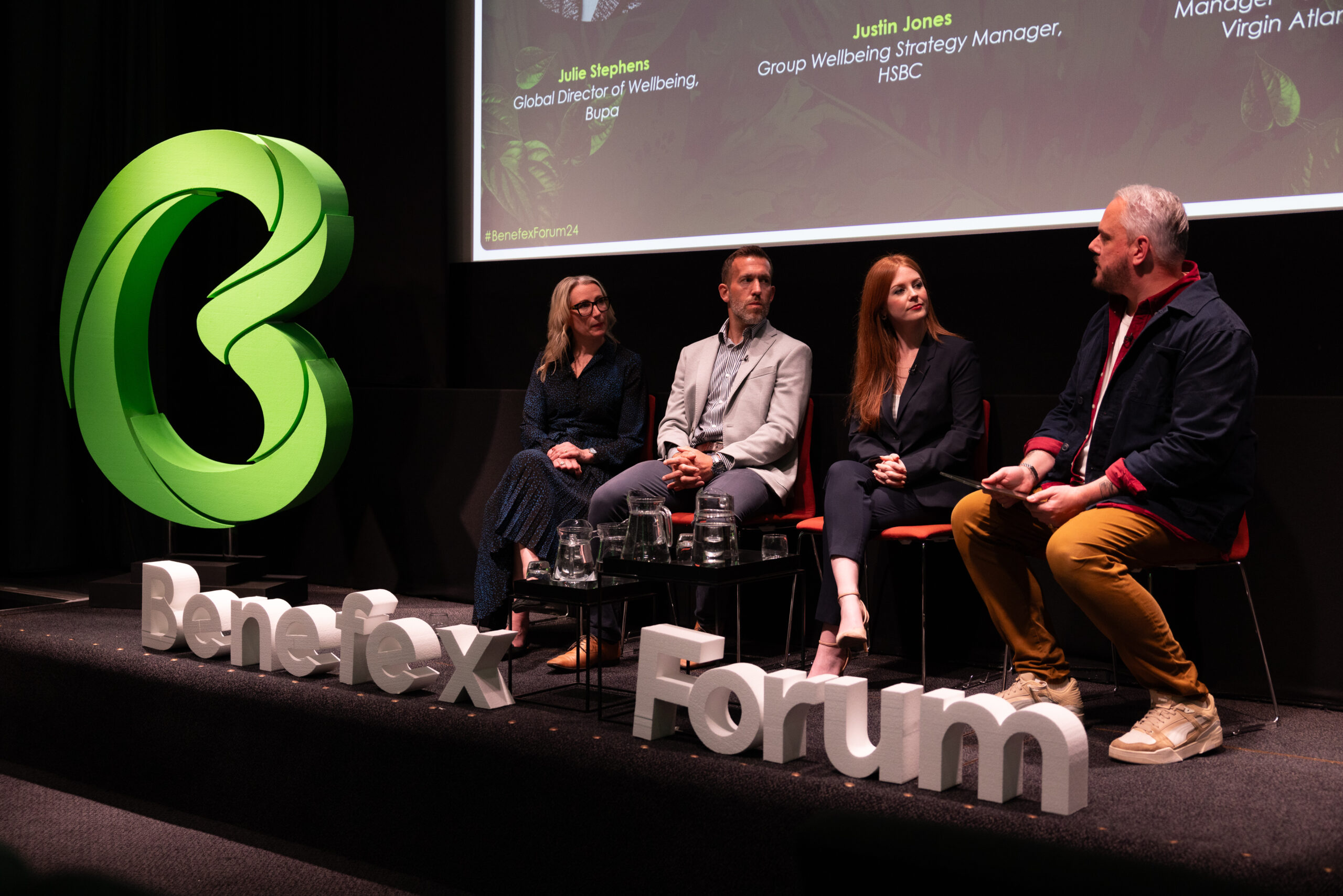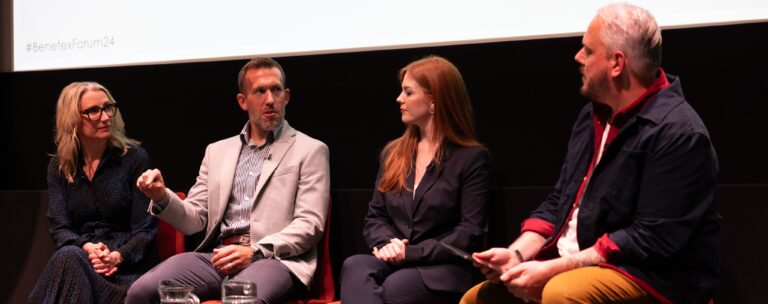
Employee Wellbeing, Global
Customer insights – How global brands are using employee wellbeing to elevate their EVP
04-10-2024
With 81% of employees stating that their employee experience is more important now than a year ago, how can you deliver an EVP that places wellbeing at its core?
The EVP has undergone significant transformation over the past decade. Previously shaped around what employers wanted to offer, recent events like the pandemic and cost-of-living crisis have shifted its focus onto employee needs. With 42% of employees saying their expectations of their employer for wellbeing support have increased in the past year alone, it’s clear that wellbeing is now at the forefront of reward and benefits strategies.
We were recently joined in panel discussions by HR and Reward leaders Julie Stephens, Global Director of Wellbeing at Bupa, Jen Hutchings, Wellbeing Manager at Virgin Atlantic, Justin Jones, Group Wellbeing Strategy Manager at HSBC, and Rebecca Marshall, Wellbeing Lead at Deloitte. They shared their experiences of integrating employee wellbeing into the core of their EVP – here are some takeaways.
Three key strategies from global industry leaders
1. Make wellbeing a strategic priority

With 84% of employers now considering wellbeing support a critical pillar of a great employee experience, and 55% of employees basing their decision to join a company on how committed an organisation is to employee wellbeing, the importance of integrating wellbeing into the EVP is undeniable.
Jen Hutchings, Wellbeing Manager at Virgin Atlantic emphasised how central wellbeing is to their brand identity: “it’s absolutely fundamental and I think that we can’t move away from this… When [people] come to work for a company, they expect that they’re going to be looked after. It’s something that we link so closely to our image and our brand. And at Virgin Atlantic, it goes above and beyond just looking after our people, but it actually impacts how we deliver our service, the ethics that we have as a company, and our ESG model; it’s absolutely fundamental to who we partner with and who wants to partner with us.” Hutchings shared how this commitment and the initiative Virgin Atlantic implemented have increased colleague satisfaction, improved employee wellbeing scores and even bolstered customer satisfaction over the past year.
Similarly, Julie Stephens, Global Director of Wellbeing at Bupa explained how they have aligned internal wellbeing strategies with the company’s broader mission: “Our purpose is longer, healthier, happier lives and a better world… If you want your people to take care of your customers, take care of them. And having them thriving, not just existing at work, will enable them to deliver a wonderful service. We see correlation between this and wellbeing scores and NPS as well.”
By putting wellbeing front and centre of the employer brand, organisations can also improve productivity and profitability. Bupa provided primary health care access for their care home workforce: “what they really needed was primary health care. It wasn’t ‘when I get really sick’, it was ‘I can’t get hold of a GP’, ‘I need support for my musculoskeletal health’ kind of issues.” After Bupa addressed this for their own people, they found that their clients were also struggling to fix the same issue: “our clients are seeing rises in absence because employees can’t get access to primary health care through most health systems.”
Stephens, who has a global remit, also highlighted that “it isn’t just in the UK. Most health systems are really creaking at the seams. So, it’s a big issue everywhere.”
2. Communicate wellbeing effectively
Effectively communicating wellbeing benefits is crucial for attracting, engaging and retaining the best people. With 60% of global organisations planning to increase investment in communication over the next 12 months, ensuring wellbeing support is easily accessible for all employees, including the 80% who are deskless, is a key challenge.
Virgin Atlantic tackled this by making their wellbeing and benefits hub accessible to their cabin crew via an app and QR code. Jen Hutchings shared how they turned “[our wellbeing hub] into a QR code and an app that [our cabin crew] can then access on their work iPads and phones.”
Julie Stephens also noted the importance of a seamless user experience: “There’s a system enablement piece there… it doesn’t really matter where the team sits, as long as the experience is seamless.”
Hutchings expanded on this, describing how Virgin Atlantic, through partnering with Benefex to implement OneHub, have created a one-stop shop for wellbeing and benefits: “we’ve worked with our benefit partners and suppliers to really maximise the content and the support and guidance that they can provide. Not only do we advertise our services, but we also provide guidance toolkits for leaders, we provide policy information, how to apply policy, how as a leader you can have wellbeing conversations, and signpost our diversity and inclusion networks.” Hutchings referenced the importance of understanding how to bring wellbeing initiatives together into one seamless experience, sharing that since their launch last year, “60% of the workforce have now visited the hub at least once… It’s made such a difference to our efficiency when we talk to people about wellbeing.”

Rebecca Marshall, Wellbeing Lead at Deloitte highlighted that effective communication isn’t only about reaching employees, but also about engaging leadership in the conversation around wellbeing. She explained how important it is to use the right language to capture leaderships’ attention: “If leadership are talking about wellbeing and it’s at the table, you can use language that’s appropriate to them for them to tune in and to listen. Because sometimes the word wellbeing, it can be fluffy, and it can be generic… You can use words that are more suitable, like work-life balance, flexibility, happiness, health. Use words that people relate to as opposed to wellbeing – it’s about using the language that you have in your company to speak to your leadership and get them onboard.”
Justin Jones, Group Wellbeing Strategy Manager at HSBC underscored the need for closely aligning wellbeing and benefits teams to create a unified communications approach: “The end user doesn’t always know what sits in benefits and what sits in wellbeing, they just want help and support. Aligning the two can reduce confusion and allows for clearer and more consistent communication.” Making wellbeing part of everyday conversation, by looking for opportunities to promote through other pre-existing channels, can reap rewards. After asking about wellbeing at the end of their employee engagement survey, HSBC signposted employees to their global wellbeing hub, increasing traffic to the site by 580%.
3. Deliver personalised wellbeing support
Employees increasingly expect personalised wellbeing and benefits support – they want to be treated as an ‘audience of one’.
The first step to getting more personalised in your approach is understanding how employees are engaging with what’s on offer and seeking their feedback. Rebecca Marshall, Wellbeing Lead at Deloitte, shared how Deloitte Ireland continuously evolve their wellbeing strategy based on employee feedback: “I suppose the most important thing we do now is ask our people what they want, check in, and do our Pulse surveys. We have a quarterly Engage for Change [survey] that’s anonymous and people can put their verbatim comments in, or they can tell us how they’re feeling and rate us honestly. And I think you’re going nowhere if you’re not asking people about what they want. You can’t do it all, but you can review and improve where possible and we review constantly because it’s constantly changing.”

Rebecca Marshall, Wellbeing Lead at Deloitte highlighted that effective communication isn’t only about reaching employees, but also about engaging leadership in the conversation around wellbeing. She explained how important it is to use the right language to capture leaderships’ attention: “If leadership are talking about wellbeing and it’s at the table, you can use language that’s appropriate to them for them to tune in and to listen. Because sometimes the word wellbeing, it can be fluffy, and it can be generic… You can use words that are more suitable, like work-life balance, flexibility, happiness, health. Use words that people relate to as opposed to wellbeing – it’s about using the language that you have in your company to speak to your leadership and get them onboard.”
Justin Jones, Group Wellbeing Strategy Manager at HSBC underscored the need for closely aligning wellbeing and benefits teams to create a unified communications approach: “The end user doesn’t always know what sits in benefits and what sits in wellbeing, they just want help and support. Aligning the two can reduce confusion and allows for clearer and more consistent communication.” Making wellbeing part of everyday conversation, by looking for opportunities to promote through other pre-existing channels, can reap rewards. After asking about wellbeing at the end of their employee engagement survey, HSBC signposted employees to their global wellbeing hub, increasing traffic to the site by 580%.
3. Deliver personalised wellbeing support
Employees increasingly expect personalised wellbeing and benefits support – they want to be treated as an ‘audience of one’.
The first step to getting more personalised in your approach is understanding how employees are engaging with what’s on offer and seeking their feedback. Rebecca Marshall, Wellbeing Lead at Deloitte, shared how Deloitte Ireland continuously evolve their wellbeing strategy based on employee feedback: “I suppose the most important thing we do now is ask our people what they want, check in, and do our Pulse surveys. We have a quarterly Engage for Change [survey] that’s anonymous and people can put their verbatim comments in, or they can tell us how they’re feeling and rate us honestly. And I think you’re going nowhere if you’re not asking people about what they want. You can’t do it all, but you can review and improve where possible and we review constantly because it’s constantly changing.”
Julie Stephens highlighted the critical role mangers play in providing this personalisation: “we describe what our expectations are of them [managers] – knowing how your people are from a wellbeing perspective, mentally and physically, is part of your job. We also have a tool that we call Personal Energy… It’s a team-facilitated conversation to help managers and team members identify the signs that they exhibit when veering between thriving and feeling unfulfilled at work. That level of awareness, both for the individual and for the manager, is really critically important.”
Additionally, showcasing real employee stories is an effective way to drive engagement with benefits and wellbeing initiatives. Stephens shared that they “regularly have employees sharing the story of a benefit that they’ve accessed and how it’s helped them.”
The business case for putting wellbeing at the centre of your EVP
With employee’s expectations of their employer and their benefits growing exponentially, understanding and meeting these expectations can foster a highly motivated and engaged workforce, leading to increased productivity, retention and colleague satisfaction. Indeed, wellbeing is the number #1 outcome of benefits for employees.
Justin Jones pointed out the financial benefits of investing in wellbeing, citing an Oxford University paper that found a positive correlation between wellbeing investments and firm performance. He noted, “we want to make our people healthier, not only because it’s better for them, but because retention will go up, share price might improve and performance is enhanced. We’re now starting to see the supporting [data] to say it isn’t just an input, it is an output as well.”
By effectively communicating wellbeing benefits, balancing proactive and reactive strategies, and aligning wellbeing with organisational values, employers who centre their EVP around wellbeing can make a real tangible difference to their employee’s lives. And those that do will reap the rewards when it comes to business performance.
To dive deeper into how you can elevate employee wellbeing in your organisation, watch the on demand recording of this session.

Gethin Nadin
Chief Innovation Officer, Benefex


